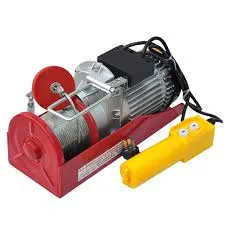


The Working Principle of Chain Hoists
A chain hoist is a type of mechanical device used for lifting and lowering heavy loads. It operates on simple mechanical principles and has found widespread applications in various industries, including construction, manufacturing, and warehousing. Understanding the working principle of a chain hoist can help us appreciate its utility and the physics that enable it to perform heavy lifting tasks efficiently and safely.
At its core, a chain hoist consists of a few key components the chain, the pulley system, the hook, and the winding mechanism. The primary working principle behind a chain hoist is based on the principles of leverage and mechanical advantage.
The Working Principle of Chain Hoists
The advantage of a chain hoist lies in its ability to lift significantly heavier loads than the operator could manage manually. This is achieved through the configuration of the chain and the way it interacts with the pulleys. When the load is lifted, the hoist reduces the amount of force required by the operator to lift the heavy item, making heavy lifting more manageable and efficient.

There are various types of chain hoists, including manual chain hoists and electric chain hoists. Manual chain hoists rely entirely on human power to operate, using a hand chain that the user pulls to lift the load. Electric chain hoists, on the other hand, use an electric motor to power the winding mechanism, allowing for quicker and easier lifting with less physical effort from the operator. These electric versions often come with additional features such as limit switches and emergency stops to enhance safety during operation.
Safety is an essential consideration when using chain hoists. Overloading a hoist can lead to failure and potentially catastrophic accidents. Therefore, each hoist is designed with a specific load capacity, and it is critical for operators to adhere to these limits. Proper training in the use of chain hoists, regular maintenance checks, and adherence to safety protocols can help minimize risks associated with their operation.
Moreover, chain hoists are designed to be both portable and fixed, allowing them to be used in a variety of settings. In construction sites, for instance, they can be used to lift building materials or heavy equipment. In warehouses, they help in organizing heavy goods and even during the loading and unloading processes.
In conclusion, the working principle of chain hoists is based on basic mechanical engineering principles that maximize efficiency and safety when lifting heavy loads. Their simplicity and effectiveness have made chain hoists a vital tool in various industrial applications. Understanding how they work not only helps in effectively utilizing these devices but also underscores the importance of safety and proper handling practices in ensuring successful operations.



